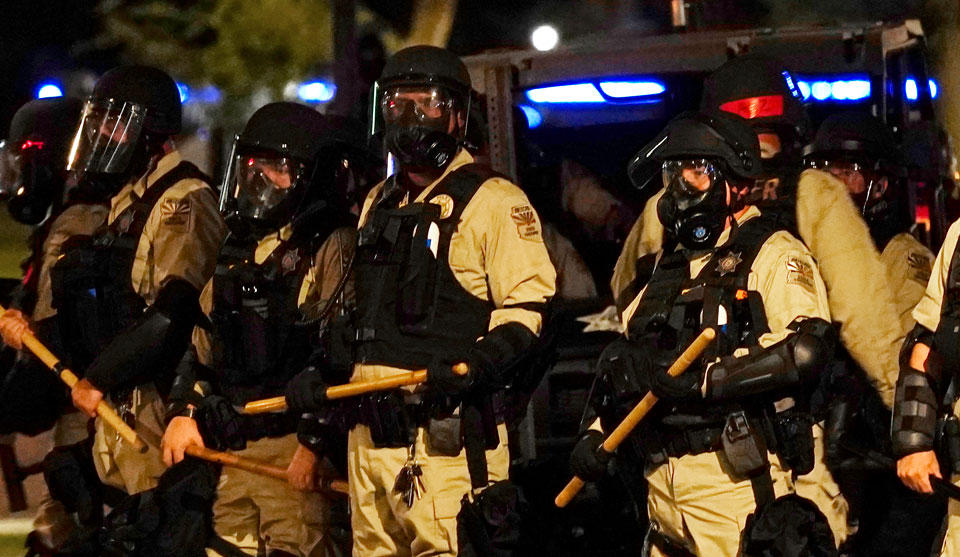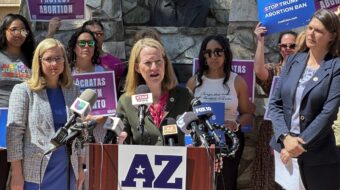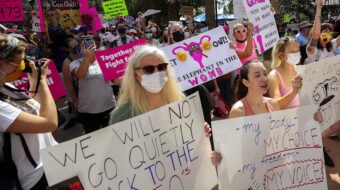
PHOENIX—In an extremely negative reaction to women’s rights, Arizona state troopers, stationed atop the state Capitol in Phoenix, teargassed 1,000-1,500 peaceful demonstrators the day after the U.S. Supreme Court’s right-wing majority tossed a woman’s constitutional right to abortion overboard, an Arizona woman caught in the barrage says.
Liz Perrachio, an AFSCME retiree from Mesa, told People’s World the troopers also made sure the participants got the full force of the gas. Her colleague, convention delegate Susan Kusar of Sedona, attended a later protest, on July 4, in Flagstaff in Arizona’s northwest.
That protest, Kusar added, drew everyone from teenagers chanting “Abort the court!” to participants in walkers and wheelchairs, including older men. “Why should our grandchildren have to go through what their grandmothers did?” she quoted the men as asking. The women discussed the protests in a July 12 interview during the union’s convention in Philadelphia.
The State Police not only fired tear gas projectiles at the Phoenix crowd but sent canisters far enough to block the one available street exit from Capitol Square, the demonstration site. The state Capitol itself and adjacent legislative offices flank that plaza.
“There was no police presence and no media” when Perrachio and a friend, Luisa Pedraza, arrived around 8 pm, she said. That made the police’s fusillade a surprise.
“All of a sudden, the Department of Public Safety” troopers “started shooting tear gas from the roof. There was no warning whatsoever. It landed behind us and we were inundated.”
An Internet check showed several local TV stations—even including Fox’s Channel 10—later reported the tear gas attack. Fox, infamous for commentators’ rightist slants, paired its coverage with video of anti-abortionists. The New York Times and the British paper The Guardian included Phoenix in their roundups of pro-abortion demonstrations in the U.S.
The Phoenix demonstration lasted all day on June 25, the day after the justices outlawed abortion. The effects of the tear gas—stinging eyes and throat and skin that “felt like it was burning”—lingered for 18-24 hours, Perrachio reported. “Even the next morning, my eyes were still blurry.”
She feared Pedraza, who suffers from asthma and was recovering from surgery, would need to be hospitalized. She didn’t. “But Luisa had trouble breathing.”
Demonstrators “ran to the memorial plaza across the street,” which was “the one way out. But they (the troopers) were shooting tear gas to block it.”
Like other demonstrators from coast to coast, the Phoenix and Flagstaff groups denounced the court’s 5-4 ruling upholding Mississippi’s draconian anti-abortion law. The deep red state’s last abortion clinic challenged the Republican-dominated state government’s diktat. The majority justices seized the case to invalidate the 1973 pro-abortion ruling, Roe v Wade.
Republican presidents named all five of the court’s majority. Those justices sided with Mississippi and brushed aside defenses of abortion from the Coalition of Labor Union Women, other unions and women’s rights, civil rights, and labor groups.
Justice Samuel Alito, writing for the majority, used the case to void Roe, sending hundreds of thousands of demonstrators—male, female, straight, lesbian, gay, trans, and cis-gendered people—into the streets around the U.S. His ruling also forced the clinic, Jackson Women’s Health, to close for good on July 6.

“Conservatives say, ‘Oh, my God, we gotta save the babies,’” Kusar said. But after the babies are born, the rightists “throw out the child” by refusing to support kids and parents.
The court’s ruling prompted rising promises of political participation by progressive forces from now through Election Day and beyond. They’re focusing not just on the Supreme Court, but on special interests—led by the radical right—who got Republican presidents to name the justices, and Republican senators who voted to confirm them.
That group includes more than a dozen Republican senators, such as Florida’s Marco Rubio, who face the voters this fall and who confirmed all three Donald Trump-named justices whose votes, in turn, swung the court. Another, Iowan Charles Grassley, is the sole senator seeking re-election who has voted to confirm all five of the Republican-named justices.
The political tie in Arizona is that the troopers’ bosses answer to retiring Republican Gov. Doug Ducey. Like most other Republicans, Ducey hates abortion rights.
But “it’s always about the money,” Kusar commented. She added the court’s ruling has energized Arizonan women to challenge the rightists and the court, even in deep-red sections of the Grand Canyon State. Reports indicate similar plans by abortion supporters elsewhere.
“There have been all Republicans on the ballot” and no Democrats “for 20 years” in Sedona, Kusar explained. “Now we have Democrats, two women and a man.” In Sedona alone, she noted, membership in the local Red Rock Democratic Club has doubled since the court’s ruling.












Comments